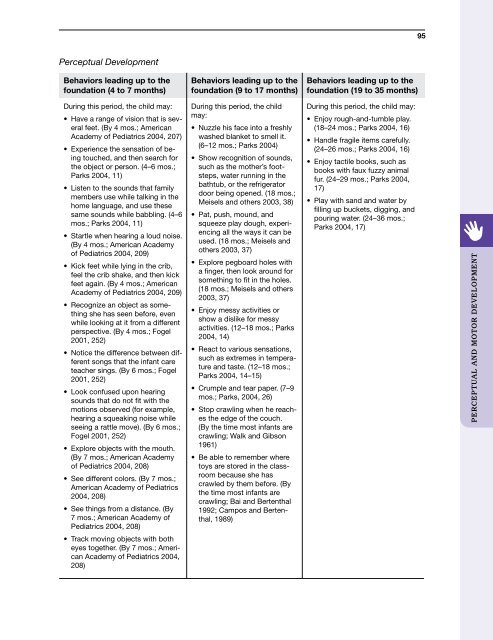Infant Toddler Learning & Development Foundations
Infant Toddler Learning & Development Foundations
Infant Toddler Learning & Development Foundations
Create successful ePaper yourself
Turn your PDF publications into a flip-book with our unique Google optimized e-Paper software.
Perceptual <strong>Development</strong><br />
Behaviors leading up to the<br />
foundation (4 to 7 months)<br />
During this period, the child may:<br />
• Have a range of vision that is several<br />
feet. (By 4 mos.; American<br />
Academy of Pediatrics 2004, 207)<br />
• Experience the sensation of being<br />
touched, and then search for<br />
the object or person. (4–6 mos.;<br />
Parks 2004, 11)<br />
• Listen to the sounds that family<br />
members use while talking in the<br />
home language, and use these<br />
same sounds while babbling. (4–6<br />
mos.; Parks 2004, 11)<br />
• Startle when hearing a loud noise.<br />
(By 4 mos.; American Academy<br />
of Pediatrics 2004, 209)<br />
• Kick feet while lying in the crib,<br />
feel the crib shake, and then kick<br />
feet again. (By 4 mos.; American<br />
Academy of Pediatrics 2004, 209)<br />
• Recognize an object as something<br />
she has seen before, even<br />
while looking at it from a different<br />
perspective. (By 4 mos.; Fogel<br />
2001, 252)<br />
• Notice the difference between different<br />
songs that the infant care<br />
teacher sings. (By 6 mos.; Fogel<br />
2001, 252)<br />
• Look confused upon hearing<br />
sounds that do not fit with the<br />
motions observed (for example,<br />
hearing a squeaking noise while<br />
seeing a rattle move). (By 6 mos.;<br />
Fogel 2001, 252)<br />
• Explore objects with the mouth.<br />
(By 7 mos.; American Academy<br />
of Pediatrics 2004, 208)<br />
• See different colors. (By 7 mos.;<br />
American Academy of Pediatrics<br />
2004, 208)<br />
• See things from a distance. (By<br />
7 mos.; American Academy of<br />
Pediatrics 2004, 208)<br />
• Track moving objects with both<br />
eyes together. (By 7 mos.; American<br />
Academy of Pediatrics 2004,<br />
208)<br />
Behaviors leading up to the<br />
foundation (9 to 17 months)<br />
During this period, the child<br />
may:<br />
• Nuzzle his face into a freshly<br />
washed blanket to smell it.<br />
(6–12 mos.; Parks 2004)<br />
• Show recognition of sounds,<br />
such as the mother’s footsteps,<br />
water running in the<br />
bathtub, or the refrigerator<br />
door being opened. (18 mos.;<br />
Meisels and others 2003, 38)<br />
• Pat, push, mound, and<br />
squeeze play dough, experiencing<br />
all the ways it can be<br />
used. (18 mos.; Meisels and<br />
others 2003, 37)<br />
• Explore pegboard holes with<br />
a finger, then look around for<br />
something to fit in the holes.<br />
(18 mos.; Meisels and others<br />
2003, 37)<br />
• Enjoy messy activities or<br />
show a dislike for messy<br />
activities. (12–18 mos.; Parks<br />
2004, 14)<br />
• React to various sensations,<br />
such as extremes in temperature<br />
and taste. (12–18 mos.;<br />
Parks 2004, 14–15)<br />
• Crumple and tear paper. (7–9<br />
mos.; Parks, 2004, 26)<br />
• Stop crawling when he reaches<br />
the edge of the couch.<br />
(By the time most infants are<br />
crawling; Walk and Gibson<br />
1961)<br />
• Be able to remember where<br />
toys are stored in the classroom<br />
because she has<br />
crawled by them before. (By<br />
the time most infants are<br />
crawling; Bai and Bertenthal<br />
1992; Campos and Bertenthal,<br />
1989)<br />
Behaviors leading up to the<br />
foundation (19 to 35 months)<br />
During this period, the child may:<br />
• Enjoy rough-and-tumble play.<br />
(18–24 mos.; Parks 2004, 16)<br />
• Handle fragile items carefully.<br />
(24–26 mos.; Parks 2004, 16)<br />
• Enjoy tactile books, such as<br />
books with faux fuzzy animal<br />
fur. (24–29 mos.; Parks 2004,<br />
17)<br />
• Play with sand and water by<br />
filling up buckets, digging, and<br />
pouring water. (24–36 mos.;<br />
Parks 2004, 17)<br />
95<br />
PERCEPTUAL AND MOTOR DEVELOPMENT
















